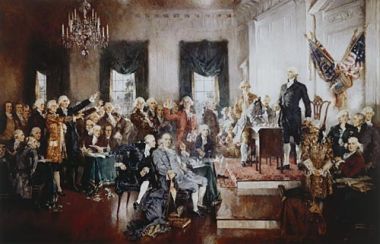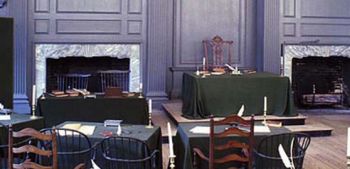U.S. Constitutional Convention

The U.S. Constitutional Convention was called by the American states in 1787 to deal with the weakness of the current system. With George Washington presiding, 55 delegates met in secret in Philadelphia and drafted a new Constitution. It was approved by Congress and sent to the states for ratification. All 13 states ratified and the new government took office in March, 1789, with George Washington as President.
Demand for reform
By 1785, newspaper essayists and petitioners in favor of national trade policies were demanding a vigorous, expanding, interdependent continental economy. They envisioned a national union whose primary purpose was to create a continental marketplace that could operate free of obstruction by contrived, and unnecessary, provincial entities. Washington spoke for many American nationalists dismayed at the national weakness and loss of national pride. He knew that the Revolution had nearly been lost because of the impotence of the national government; Washington feared that the nation might not be so fortunate during the next emergency.[1]
In the late 1780s, a crisis of self-confidence shook the new nation. Was its government strong enough to guarantee internal cohesion and to provide for the common defense against outside enemies (such as Britain and Spain), or indeed to defend against internal revolts (such as Shays Rebellion in Massachusetts, in 1786–87)? [2]
The nationalists met at the 1786 Annapolis Conference, which originated from a series of commercial meetings among the northeastern states. Some historians see it as an unsuccessful experiment in reforming the Articles of Confederation. Others emphasize that the nationalists at Annapolis, especially Alexander Hamilton of New York and James Madison of Virginia, used it to call for the Philadelphia convention. The Annapolis experience led Madison and the other nationalists to consider designing a new federal political system with a powerful central government. The report of the Conference, sent to Congress, requested "the appointment of Commissioners, to meet at Philadelphia on the second Monday in May next."
Leading nationalists, led by Washington, Hamilton, and Benjamin Franklin called for a new constitution. The old Congress (based in New York) agreed and called the states to send delegates to a convention in Philadelphia in May of 1787. This convention, over the course of the summer, drew up a new constitution that was submitted to Congress and eventually to state ratification conventions for approval. James Madison, who arrived in Philadelphia early to map out an initial plan for debate, is called "the father of the Constitution." [3] Madison took copious notes of the debates, which he refused to release until the last delegate was dead; they were published posthumously. [4]
Political parties did not exist in 1787 and were not mentioned in the Constitution. In each state, factions competed for control of the legislatures and the governorships. Because the states controlled their representatives to Congress, a geographically based factionalism pitting the different states against one other existed in the Continental Congress. The factions in the different states had little in common; politics did not cross state lines and no coalitions were formed that crossed state lines. Many nationalists feared Congress was too weak. [5]
Drafting the Constitution

On 29 May, Edmund Randolph proposed to replace the current government with a totally new structure. Randolph's Virginia Plan favored large states (Virginia had the largest population at the time) and increased the power of the central government. Among its key features were a bicameral legislature in which each state's representation would be allocated in proportion to its population and the provision of national veto power over state legislation. On 15 June, the smaller states countered with the New Jersey Plan, introduced by William Paterson. In contrast to the Virginia Plan, it called for maintaining the Articles of Confederation's unicameral legislature with representation allocated equally among the states. The convention debated the New Jersey option until 19 June, when it was voted down. Therefore, the Virginia Plan, much expanded and elaborated upon in the course of four-and-a-half months, formed the basis of the Constitution.
Madison is given the major credit for shaping the key provisions, but as Robertson (2005) shows, he had to compromise. Madison wanted broad national authority independent of state governments and population-based congressional representation. Delegates from smaller states opposed had other goals: to nationalize only selective public goods, to maintain most state policy autonomy, and to minimize contingencies imposed by other governments. Connecticut's delegates, particularly Roger Sherman, played a pivotal role in revising Madison's agenda. Madison's convention opponents are responsible for a Constitution that nationalized only enumerated public goods and imposed potentially high transaction costs on any further nationalization of policy authority. They helped make federalism a lasting political weapon used to win substantive policy outcomes, says Robertson.
Small states versus large
Slonin (2000) studies the debates on federal powers, including those on a federal legislative veto and the advice and consent of the Senate. He finds a complex interaction between contending interests and groups, as well as a discriminating response to the need to balance the requirements of the national government with the preservation of state influence. Nearly all areas of discussion at the convention were dominated by differences between the interests of large states and small states. The first outline of the national government reflected more of a compromise between the large and small states and between nationalists and those intent on maintaining states' interests than many Federalists preferred. Instead of Madison's vision of a national government freed from any reliance on states as seen in the Virginia Plan, the final version of the Constitution granted the states a substantial role and basic involvement in the operation of the national government.
Executive, Legislative and Judicial branches
The presidency was not controversial. Six influential delegates[6] worked out a system of a strong president to balance a strong Congress. The result was four basic characteristics became permanent: a single executive (rather than a committee or rotation), no constitutional council whose permission was necessary, election by the states through the electoral college, and broad presidential powers over administration, foreign affairs, the military.
Slavery
The Constitution was written at a time when all the northern states were moving toward emancipation, and most leading southerners doubted the long-term viability of the institution. The Constitution did not use the word "slavery", but it allowed for the abolition of slave importation from abroad after 20 years,[7] for the return of fugitive slaves, and for counting 3/5 of the slave population (and all of the free population) in computing representation in the House and electoral college. That was a compromise between counting all the slaves (which would favor the South) or none (which would favor the North). Benjamin Franklin helped broker the compromises.[8]
Finance
Grubb (2006) argues the monetary powers embedded in the Constitution were revolutionary and led to a watershed transformation in the nation's monetary structure. They included determining what monies could be legal tender, who could emit fiat paper money, and who could incorporate banks. Grubb looks at the convention debates to show how these powers evolved and led to the specific powers adopted, which were a rejection of the old colonial system. Grubb shows they codified the powers into supreme law rather than leaving them to legislative debate and enactment.
Ratification
An intense debate on ratification pitted the "Federalists" against the "Anti-Federalists," with the former gaining the upper hand. The Anti-Federalists were deeply concerned about the theoretical danger of a strong central government (like that of Britain) that some day could ruin republicanism and usurp the rights of the states. Madison and Hamilton (joined by John Jay) countered with a series of newspaper essays, the Federalist Papers, that helped New York to ratify. All the states ratified but as a condition, the Anti-Federalists insisted on a bill of rights which would meet most of their serious objections. The supporters of the Constitution agreed (and the Bill of Rights became part of the Constitution in 1791). The Anti-Federalist element had never comprised an organized group, and had no national leaders. By 1791 its issues were moot; some left politics, and most joined the Jeffersonian Republican Party by 1796. [9]
The pro-Constitution forces, led by Washington and Hamilton, formed a new government in 1789, with Washington as president. Madison became a leader in the House, where he sponsored the Bill of Rights. Under pressure from his district he resisted moves toward a strong central government, especially those promoted by Hamilton.
The Federalist Party originated around 1792-3 and comprised a somewhat different coalition, including most supporters of the Constitution in 1787-88 as well as entirely new elements, and even some opponents of the Constitution (such as Patrick Henry.) Madison largely wrote the Constitution and thus was a "Federalist" in 1787-88, but by 1792 he opposed the program of the Hamiltonians and their new "Federalist Party."
- ↑ Ferling; A Leap in the Dark p 258-9.
- ↑ Morris, (1987) p. 266
- ↑ Morris (1987) pp 267-97.
- ↑ Farrand (1911) p xv. The implication is that Madison did not want commentators using his notes to discover what the delegates meant by various provisions.
- ↑ McDonald, (1965), pp 17-32 on Congress; pp 33-132 covers each state.
- ↑ George Washington, Alexander Hamilton, James Madison, Rufus King, James Wilson, and Gouverneur Morris.
- ↑ In 1808 Congress made the importation of a slave from abroad a serious crime. Britain at the same time outlawed the international slave trade; a small trickle of slaves were smuggled into the U.S. Edward Channing, The Jeffersonian System, 1801-1811 (1906 100-110.
- ↑ Morgan (2001); Finkelman (1987)
- ↑ Morris The Forging of the Union: 1781-1789 pp 298-322.